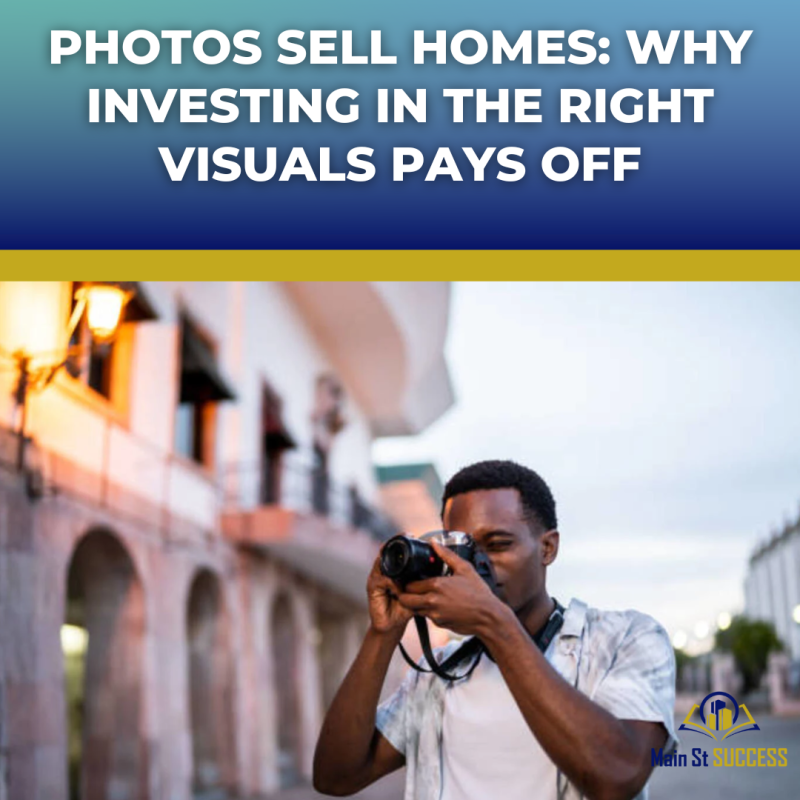Blog
Photos Sell Homes: Why Investing in the Right Visuals Pays Off
The first impression of a home no longer happens at the front door. It happens online. Buyers scroll through listings at lightning speed, and the photos are what stop them or make them keep scrolling. As a realtor, you know location, price, and condition matter, but if the visuals don’t spark interest, many potential buyers won’t even make it to the showing. That’s why investing in high-quality photography and other visuals is one of the smartest decisions you can make when marketing a property.
The Psychology Behind Photos
Home buying is as much an emotional decision as it is a financial one. Photos trigger that emotional response long before a buyer considers the square footage or school district. A well-composed, brightly lit image of a living room invites people to imagine themselves hosting friends. A clean, sun-filled kitchen photo encourages them to envision family meals. Poor-quality images, on the other hand, can make even a great house feel uninviting.
Studies show that listings with professional photos receive significantly more views online than those with amateur snapshots. More clicks lead to more showings, and more showings lead to faster offers. In competitive markets, strong visuals can even drive bidding wars.
Why Smartphone Photos Aren’t Enough
Nearly everyone carries a smartphone with a decent camera these days. While convenient, phone photos usually fall short for real estate listings. Without proper lighting, wide-angle lenses, and post-processing, smartphone shots often look dark, cramped, or distorted.
Professional real estate photographers understand how to highlight a property’s best features and minimize its weaknesses. They use specialized equipment to capture wide, balanced images that show the true scale of a room. They know how to work with natural and artificial light to make spaces feel open and inviting. They also edit photos to ensure colors look natural and details stand out.
When buyers compare listings side by side, the difference between a smartphone photo and a professional one is clear. The listing with polished images is far more likely to stand out.
The Role of Staging in Photography
Staging and photography go hand in hand. Even the best photographer can’t disguise cluttered countertops, overcrowded furniture, or poor lighting. Before photos are taken, preparing the home is essential.
Simple staging steps such as removing personal items, opening curtains, and arranging furniture to maximize space can dramatically change how photos turn out. Professional stagers often work directly with photographers to ensure each shot looks appealing and tells a story. Realtors who guide their clients through this preparation process consistently achieve better results in their marketing.
Beyond Still Photos: The Rise of Video and Virtual Tours
While still photography is the foundation of real estate marketing, buyers increasingly expect more. Video walkthroughs and 3D virtual tours provide a sense of flow and scale that photos alone can’t convey. For out-of-town buyers or those with busy schedules, these tools can even serve as a substitute for an in-person showing.
Drone photography adds another layer, especially for homes with large lots, unique architecture, or scenic surroundings. Aerial shots can showcase features like a landscaped backyard, nearby amenities, or the home’s position within a neighborhood.
Investing in these additional visuals demonstrates professionalism and commitment to marketing. More importantly, it expands your reach by appealing to buyers who want to fully experience a home before visiting.
The Cost of Cutting Corners
Some sellers hesitate to pay for professional photography, thinking it’s an unnecessary expense. But the cost of poor visuals is often far greater. A home that lingers on the market because the photos didn’t attract enough attention can lead to price reductions, extended carrying costs, and frustration for both the seller and the realtor.
In contrast, professional photos often pay for themselves many times over. Faster sales and stronger offers more than offset the upfront expense. For realtors, building professional photography into your standard marketing package also strengthens your brand. It signals to clients that you take their listing seriously and are willing to invest in results.
How Buyers Interpret Bad Photos
It’s worth considering how buyers interpret low-quality listing photos. Grainy or poorly lit images often make them wonder what the seller is hiding. Crooked angles can make rooms feel smaller or awkwardly shaped. A lack of exterior shots might suggest something undesirable about the outside of the property.
In today’s market, where buyers are conditioned to expect polished visuals in nearly every area of their lives from social media ads to online shopping, subpar real estate photos can feel out of place and unprofessional. This perception can hurt not only the property’s image but also the realtor’s reputation.
Tips for Maximizing the Value of Professional Photography
Working with a professional photographer doesn’t mean handing off all responsibility. Realtors can take steps to make sure the process runs smoothly and the results align with the marketing strategy.
Plan the shoot strategically. Schedule photography when natural light is best, usually mid-morning or late afternoon.
Prepare the home thoroughly. Encourage sellers to declutter, clean, and stage before the photographer arrives.
Highlight the home’s best features. Communicate with the photographer about what aspects should be emphasized, such as a fireplace, custom kitchen, or backyard patio.
Think seasonally. Exterior photos look best when landscaping is in good condition. If possible, avoid taking them during winter storms or when the yard looks barren.
Leverage every angle. Ask for a mix of wide shots, detail shots, and exterior views to create a comprehensive gallery.
By being involved in the process, realtors ensure the final visuals reflect the home’s true value and appeal to the right buyers.
Building a Brand Through Consistent Visuals
Strong photography doesn’t just help individual listings. Over time, it builds a realtor’s brand. When potential clients browse past sales or current listings and see consistent, high-quality photos, it reinforces the impression that you are a professional who invests in marketing. This reputation makes it easier to win future listings, especially when competing against agents who cut corners.
Consistency also extends across platforms. Using the same polished photos for MLS, social media, flyers, and websites creates a cohesive marketing presence. Buyers begin to associate your name with well-presented homes, which translates into trust.
Final Thoughts
Photos are not an afterthought in real estate. They are the first and often most important touchpoint between a home and its potential buyers. Investing in professional photography, staging, and supplemental visuals like video or drone shots can dramatically change how quickly and for how much a property sells. For realtors, it’s not just about selling one home. It’s about building a reputation that sets you apart in a crowded market.
When every click counts, quality visuals make the difference between a listing that gets overlooked and one that gets sold.

